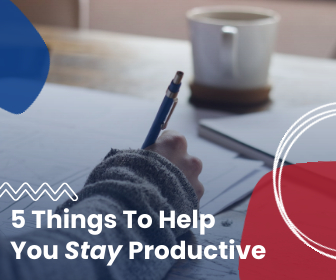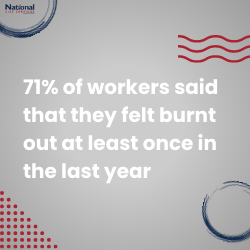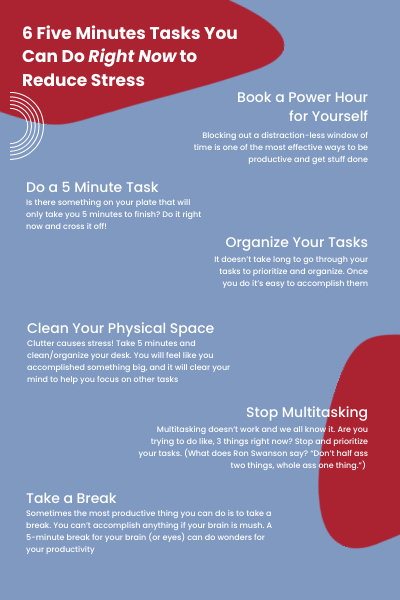5 Things To Help You Stay Productive

We often focus on tips and tricks to help your business, but nothing is important to your business than you! Did you know that April is Stress Awareness month and May is Mental Health Month? What can you do to make sure you are running at your highest capacity and stay productive?
Managing stress has been a challenge for a lot of people this year. In Asana’s Anatomy of Work 2021 study, 71% of workers said that they felt burnt out at least once in the last year. Also, 42% rated their stress levels as high or very high. When employees are stressed or exhausted, engagement and productivity dip and the whole company can feel the effects.
What Can You Do as A Team to Stay Productive?
Unfortunately, work related stress often has to do with environment. When one person id feeling burnt out on your team, it can bring the whole team down. What can you do to create a less stress inducing work environment?
Talk It Out
Ewww, right? However, it’s impossible to know what is wrong or how you can help a situation if you don’t know at the problem is. Take in interest in people you work with. Is there anything going on in their life that might be adding stress? Is a process or workflow just not working for and its making things difficult?
Once you understand how your team is feeling, don’t disregard it! See what you can do to make things run smoother.

Take Control Over Your Situation
We are all responsible for ourselves. If you are lucky enough to have anatomy in your job, use it! Think about what areas of your job are stressing you and then figure out what you can do to help the situation. For example, do you struggle with being productive in the afternoons because you hit a massive exhaustion wall? Could you be hitting that dip because you constantly don’t get enough sleep? Or does coffee make you crash? Those are things that you have control over and can change.
And after this year, more and more companies are realizing that giving their employees flexibility over schedule and in some cases, whether they want to work from home, actually increases productivity!
Minimize Distractions
The Asana study mentioned early found that “work about work” took up 60% of most employee’s days. That “work about work” is things like, meetings about processes, communicating about specific tasks, switching between tools, waiting for apps to load, searching for information, following up with team members about a project’s status, and managing shifted task priorities. A lot of those things are things that you don’t have control over. However, dealing with tasks like that can quickly give you the feeling of being on a work sized hamster wheel. That’s partly because “work about work” doesn’t feel like you are accomplishing anything.
What can help you feel in control? Figure out the right processes and find the right tools. If you can work with your team to put an effective process in place for dealing with collaborative projects. Part of that involves finding the right tools. There are so many workflow and team management tools available now that it shouldn’t be difficult to find one that works for you and your budget. (We are big fans of Teams/Planner and good old fashioned white boards.)
Time Management
Time management single handedly has the biggest impact on work stressor and burn out. Good time management can drastically increase your productivity and give you more time to focus on other aspects of your life. A healthy work-life balance will help aspects of your life, including reducing stress!
Connect Your Targets to Big Goals
Time management is about getting the work done, it about getting the right things done at the time. A big part of understanding and prioritizing what’s most important is know what your goals. And if you work for a company, what its goals are. A recent study found that only 26% of employees understand how their work relates to the overall company goals. How can you know what daily targets to set if you don’t understand where you are trying to go?
Only 26% of employees understand how their work relates to the overall company goals
This goes back to talk it out. If you have questions, ask! And if you are in a management position, work with your employees so everyone understands what they are doing to help the company reach its goals!
Prioritize and Organize
Its critical to understand what tasks are most important. Inevitably things change throughout the day; deadlines move and priorities shift. If you understand what’s most important in the grand scheme, however, it can make adapting to those changes easier. In the Asana study, they found that 29% of employees cited confusion on task priorities as a contributing factor to their burnout.

There are many different methods to prioritizing and organizing your daily tasks. The “Eat The Frog” method (named after the famous Mark Twain quote) encourages you to take care of the big or complex tasks first thing in the morning. This way you are productive right out the gate and don’t have a big task hanging over your head all day. Once you’ve eaten the frog you can move to other things.
Another popular method is David Allen’s “Getting Things Done” method. The first step in this method is write everything you need to get done down. Once you have an overview it’s easy to see what tasks are important. Writing it all down and putting it one place frees up brain power and lets you focus on actually getting the stuff done.
Plan Ahead
Writing down your targets for the next day before you finish for the night or as you think of it, helps you feel on top of the day as soon as it starts. Spending a few minutes to plan out tomorrow’s tasks is way easier than spending the first part of your day scrambling to remember what was a priority to get done that day. This will also help your work life balance because you don’t have to keep thinking about all you have tomorrow.
Say “No” or Delegate
This is a struggle, we know. But one advantage of having clear, prioritized tasks, is that you can see when a task is not a priority or not one you have time for. It’s easier to explain why you are saying no if everyone knows what your current priorities are. Sharing your clearly defined priorities with your team gives everyone more clearly. This is something that we have found to be successful. In our morning meeting we often go through what everyone’s priority tasks for the day are. By doing this, we know what each of us needs to be focusing on and how much a priority it is to reach our company goals. It also makes it easier to see where we could help.

Knowing what your team’s priorities are, can also make it easier to delegate tasks. Just because something is a priority task for you doesn’t mean it’s not important! Help it get to the right person and that benefits everyone.
Audit Your Tasks
Is there anything on your plate right now that doesn’t align with your goals? Ask yourself, is this task not a priority for today anymore? Or is it not a priority at all? If the task is still important but keeps getting moved to the bottom of your priorities, ask yourself if you are the right person to be handling it?
Another aspect of auditing task is looking at how you view the task. Are you procrastinating the task because you don’t really want to do it? It’s easy to add time to situations if want to avoid the task. However, tasks don’t usually take care of themselves. (wouldn’t that be nice?) procrastinating the task will just make it worse. And often, when we finally do something, we’ve been procrastinating, we find it wasn’t that difficult in the first place!
What have you found successful in dealing with work stress? Any time management tricks you swear by?
All The Reasons You Need A Buyer Persona

A Buyer Persona or Avatars is one of those confusing marketing things that seems to be really important, but no one ever explains why or how you can make one. Buyer Personas are especially valuable in this digital age where you can’t see your customers. They can help make your digital presence and marketing more personal.
It’s a lot easier to market to one single person than to a crowd. We’ve talked in the past about social media (and email) feels like a personal one-on-one conversation between brand and consumer. Building a buyer persona connects with that thinking. Having a buyer persona helps you to hon in on who you are reaching and who you want to reach.
What are Buyer Personas or Avatars?
In the simplest terms, a buyer persona is exemplification of all of your customers. The most common way to do this is to create a fictional person that has the most common demographics and interests of your customers. What are your customers common denominators? What do they want? What are their pain points? Taking this information and combining it into a person you can picture makes it easier to connect with the crowd. A lot of marketers recommend giving your buyer personas names.
Jim Edwards from Funnel Scripts explains buyer personas as the main character in the story of your company’s customer journey. Although your company already has its own personality, (or brand) in order to success the narrative you’re telling haws to focus on what the customer wants and needs. You are there to help them get to where they want to go. Jim Edwards example buyer persona was for a weight loss company. Their buyer persona is a middle-aged unicorn named Fred who needs to lose weight if he wants to be successful at his quests. Fred is the main character in the story. The weight-loss company is there to help him.
What information do you need to create a buyer persona?
Like any good main character, your buyer persona needs to be well rounded. It needs to have a purpose, interests, goals, and struggles. It’s especially important to know what motivates them so you can help them.

Here’s some common buyer persona attributes.
- What are their basic demographics?
What gender to they identify as? How old are they? Where do they live? What is their relationship status? Are they educated? - What do they do for work?
What’s their job title and description? But more than that, are they a decision maker? What do they influence at work? - What are their interests?
Do they have hobbies or interests? What do they do in their free time? Are they part of a community? - What do they want and why can’t they have?
This a big thing for figuring out what you can do to help them! What are their goals and dreams? What are their pain points? Like, what keeps them up at night? - Why wouldn’t they buy from you?
What’s stopping them from buying from you? What objections may they have? - What ways would they prefer to interact with you?
Do they use social media? Do like a particular social media? Is a phone call the best way to reach them?
Once you have that all that information, you will have a very clear image of who your customer is!
A lot of companies create multiple buyer personas. It is a very good way to segment out different sections of your business. It is also helpful to create a buyer persona for your ideal customer as well! You can take the information you’ve learned about your ideal customer and use it to go and get those customers.
Do you have a buyer persona for your business? And more importantly: what did you name them? 😜
Social Media Trends – 2021
Every year, as technology and culture change, social media adapts. Here’s three things that will take the forefront on social media in 2021!
Stories take over….

In the past couple years, one platform after another has adapted a “stories” feature. LinkedIn, Spotify, and Twitter all added stories features in 2020. (Pinterest added one the day this article came out!) Stories allow consumers to see bite sized pieces of content in a way that feels authentic. A lot of marketing automation platforms don’t have stories scheduling built in yet, so it’s a good idea to take some time and plan out your strategy and figure out what way of adding stories to your content will work best for you.

Go Live….
Lives have been popular on just about every platform for years. With the constant increase in content available, have that instant connection with audiences will be even more valuable in 2021.
Purpose driven brands and responsible consumerism….
2020 was defiantly a year for activism and accountability. More and more consumers expect the brands they interact with to uphold their same values. Social Media is the place where you can easily share what your company believes and what you are doing to stand up for your values.
What do you hope to see on social media in 2021?
The Truth About Your Best Weapon
 Every day, thousands of advertisers and marketers wrack their brains. How do you spread your message, sell your products and change people?
Every day, thousands of advertisers and marketers wrack their brains. How do you spread your message, sell your products and change people?
Simple. Give something away for free.
Could this be the most powerful business idea of the century? Look at Google. Giving out free things made them obscenely rich.
A free search engine, YouTube and then Chrome, the free browser everybody uses. Plus free maps, free email… on and on.
Doesn’t free make your stuff less valuable? Nope. People don’t value things because they paid. They value what others value.
Doesn’t free attract the wrong people? Sure. But it attracts everybody. And if everyone likes it, it’s valuable.
And when people are hooked on it and they need it? Now you can charge real money for it. Or create a bunch of services around it and charge for them.
Sweet.
And since free works so well… you’re bombarded by it every minute. Chances are, you won’t even finish (or get the value) of this article. All because you’re distracted by something “free.”
The Cost of “Free”
Are you an entrepreneur, marketer or creative person? You’re especially at risk for this shiny object syndrome. Creative people crave new ideas, new projects, new things.
The new thing is exciting. So you invest time and money in it. And then… something else comes along. Another new idea. Of course, with “free” training.
It’s like somebody brought free donuts in the office. Mmm… tempting. Colorful sprinkles… creamy filling… you can taste the glaze just by looking at it.
And free? Don’t you pretty much need to eat one? It’s ungrateful to say no. Stupid to pass up such an opportunity. Right? Right?
Wrong. Dead wrong. Sugarcoated lies. Poison.
More than anything, new “free” stuff keeps CEOs, CMOs and smart people like you from completing projects. Jumping ship and switching strategies? This destroys consistency and momentum. And keeps you from ever seeing your potential.
A constant stream of new and free keeps you away from the best long-term game plan… Wrong or incomplete action is far worse than no action.
How many great ideas have you “tried” (but really just threw away) because of new and free?
And oh, does new and free ever make you burn through the cash!
So many hundreds of techno tools with free trials. All so impressive, effective and fun to use.
That is, until your accountant (or empty bank account) says you’ve subscribed to too many services. And jumped between too many platforms.
Do you work with employees or business partners? Oh… this is even more terrible.
Your people won’t keep up. The new/free stuff changed direction in your business yet again. And when the previous projects, tools and goals are suddenly irrelevant?
Harvard Business Review’s grim answer: your people won’t be loyal anymore. Nor productive.
A decade ago, information overload (distraction) costs the US economy $900 billion per year. Do you think it’s any better now?
Most people spend 20 hours a week managing distractions from emails alone. And even if you could recover the money, the time is gone forever.
If someone offered you 3 days of free training, what would this really cost you?
Free training is noise. It almost never gives you all you need to master the new skill you want.
Get rid of the messes and noise in your life.
Everyone’s fighting for your attention. And too many people are stealing it. Distraction is the greatest thief of time – and you can never get it back!
Sure, sometimes you need new innovation, new ideas. They can spark life into your business. But too many sparks cause out-of-control infernos.
Make sure new ideas give you strength, not destruction.
The Great Rewards of Minimalism
 Why did Steve Jobs always wear a black turtle neck, blue jeans and his New Balance sneakers every day? As the co-founder and CEO of the most valuable company in the world…
Why did Steve Jobs always wear a black turtle neck, blue jeans and his New Balance sneakers every day? As the co-founder and CEO of the most valuable company in the world…
What did Steve know about decisions and distractions that most people don’t?
Every decision, every distraction sucks up mental energy. Even a small one, like what you’re going to wear. Instead, he wanted 100% focus on making Apple legendary.
“It’s what Apple said ‘No’ to that ultimately made them successful.” – Steve Jobs
Special forces on a military mission realize this. They maintain strict isolation. No contact with other teams, no TV, news nor internet. Why?
To protect their focus and deliver perfection on their goals.
How can you do this?
If you want results like you’ve never gotten before, get crystal clear on what you want. Then clean out all the distractions. Strengthen your focus.
Make your work environment and schedule as predictable as possible. The fewer decisions you make, the more effective they’ll be.
Once you develop this attitude, your life suddenly gets simpler. And it’s simply the fastest way to reach your goals.
Don’t Just Pay For Training, Learn Like A Master
People go crazy, even with paid training… books, conferences, seminars, multiple coaches, videos and programs.
And yet they’re completely overwhelmed. Stuff just sits on their hard drive or bookshelf. Useless. They don’t apply any of it.
Yes, you need a wealth of knowledge to build real wealth… but implementation is the key. How fast can you put the knowledge to work?
There are two kinds of learners: amateurs and masters. Both want just as badly to transform their life and business.
The amateur wants to get as much information as possible. As fast as they can. And the motivation feels good and helpful for a bit.
But as time goes by, there’s no real change.
The master learner knows exactly what their goals are. And yes, their goals might mean learning lots of skills down the road.
But what are the one or two skills to focus on right now?
And the master learner picks the right mentor or coach: somebody who stretches them just enough to change…
But not so much that the learner wants to give up: the master makes sure the training is broken down into manageable chunks. Reachable deadlines. Simple actions.
And the master doesn’t move on to anything else until they… you guessed it… mastered the skill they’re learning.
Which Kind of Learner Are You?
What does your finances, your business reveal?
Now that you know the honest truth about new ideas and free training, what will you do?
Yes, giving away free stuff can be your greatest marketing weapon. But eating up time consuming free stuff is easily the biggest business problem today.
Make it your aim to be the kool-aid producer, not just a kool-aid consumer.
And when it comes to kool-aid, only drink the flavor that makes you more alive. The kind that rockets you toward your goals.
Save 80% Time & Money: How to Market to the Crucial 20%
 Wouldn’t we all like to save 80% of our time, money and marketing effort, while getting 10 times or even 100 times the results?
Wouldn’t we all like to save 80% of our time, money and marketing effort, while getting 10 times or even 100 times the results?
However, that’s just what Cara accomplished. Let’s see how she did it, and how easily you can do the same.
Starting out, Cara did what most failing marketers do… she found a “deal” renting a cheap list of 5000 prospects for 20 cents per name. It cost her an extra dollar per person to get the offer in front of her list. Total cost: $5500. Since 40 people bought her product at $100 profit each, she got $4000 back for her effort.
Poor Cara. She lost $1500 on this campaign. (Okay, I rounded the numbers, but this is really close to what happened.) Sadly, she thought her target audience should be “everyone interested in my product.” But the school of hard knocks really motivated her to take a closer look at buyer personas and exactly who her ideal audience is.
“What things do I need to look at to find my ideal customers?” Excellent question, Cara.
Fortunately, she found a great data provider who guided her through modelling tools and buyer propensities. Cara selected a list of only 500 prospects. Sure, these extra data analytics cost $2 per name instead of 20 cents each. Was it worth it?
Well, considering she spent the same dollar per person to get her offer in front of the new list, her total cost was $1500. This time, she sold to 30 people, making sales totaling $3000. Yay for Cara! This time, instead of losing, she doubled her money.
Really though, she saved 73% of her marketing cost. And she converted 7.5 times as many prospects into sales. But, you may say, how could you get 100 times the results? Another great question.
We’ve all heard of Mr. Pareto. The original 80/20 guy. Truth is, his principle can be applied to itself. Not only will 20% of your best prospects give you 80% of your profits… The top 4% of your prospects will give you 64% of your profits. (20% of 20% and 80% of 80%.)
Wow.
So, if you can identify the top 20% of your best prospects, you can really be 16 times more profitable. And if you identify the top 4% of your prospects…wait for it…you can be 250 times more profitable . If you are not following this formula, “you are leaving millions on the table,” says Brian Kurtz, Executive Vice President of Boardroom Inc. and leading direct marketing expert.
Don’t think it’s that valuable to niche down this much? Look at Amazon. They specialize in one tiny niche after another. And even a decade ago, that’s how they sold 50% of their books. Even small businesses can compete with large companies by targeting a smaller niche like this.
How can you make this easy for your business?
 Let’s say you’re the Dallas Cowboys. Most fans will get into the stadium for $19. Some of them will get $1000 season tickets for the mediocre seats. Only a few will get the $10,000 seats near the 50-yard line. And a tiny fraction of them will dish out far more money than this to enjoy the ultra-exclusive sky boxes. How much will a raving football fanatic (with money) spend on football? A virtually unlimited amount. You want to find THIS kind of people. And you CAN (and should) find them.
Let’s say you’re the Dallas Cowboys. Most fans will get into the stadium for $19. Some of them will get $1000 season tickets for the mediocre seats. Only a few will get the $10,000 seats near the 50-yard line. And a tiny fraction of them will dish out far more money than this to enjoy the ultra-exclusive sky boxes. How much will a raving football fanatic (with money) spend on football? A virtually unlimited amount. You want to find THIS kind of people. And you CAN (and should) find them.
Even if you’re only the company selling the peanuts.
Ask yourself about demographics: Who are your best customers? How old are they? Where do they live? What about their gender, income level, education, family/marital status, occupation and ethnic background? Now, ask yourself about their motives. What makes them buy? What is their personality, attitudes, values, interests/hobbies, lifestyle and behavior?
How can you know this stuff?
It’s not as hard as you might think to learn the right way to use a propensity modelling tool. Or some brand new (and yet relatively inexpensive) methods to give you real behavior data on your ideal customers.
Stay tuned.
Or better yet, call us. We’re happy to walk you through our tools right now.
| Click here to learn more |
